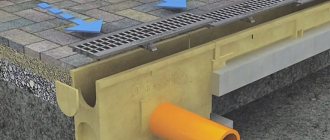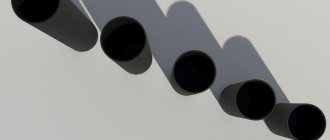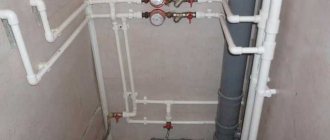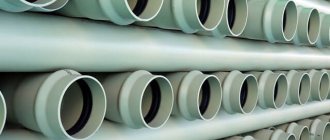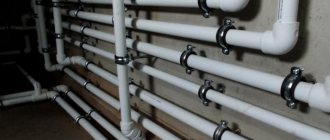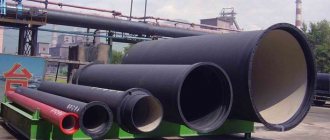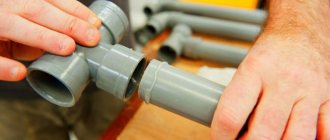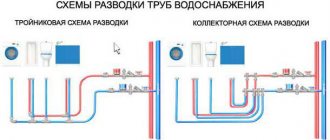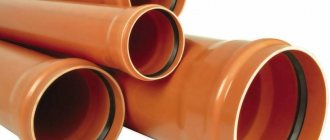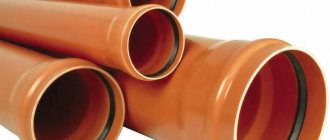In everyday life, on vacation or at work, a person constantly encounters water supply.
It has become an integral part of our life, which provides the necessary level of comfort. We pay attention to the plumbing system only if any problems arise and subsequent repairs occur. One of the defining characteristics of this system, which affects the quality of drinking water supply, is the diameter of the water supply pipe. This size must be taken into account when constructing new communications or repairing an old system, as it affects the throughput of the water supply. Small pipes will create tension and increased pressure, which can negatively affect all plumbing fixtures. The use of larger diameter water pipes will also have a negative impact on communications, and is also inappropriate from an economic point of view. Therefore, the article will discuss how pipes made of different materials differ, and how to choose them correctly for high-quality operation of the water supply system.
Which pipes are best to choose for installing water supply in a private house?
Before starting installation work, you need to understand the suitable products. At the moment, communication pipes are made of different materials and differ in operational parameters. Let's take a closer look at the available options.
Steel
Some time ago, steel pipes were the most common used for organizing plumbing in the house. No one even thought about other options, since there was simply no alternative. Nowadays, with a large selection, the demand for steel pipes has remained due to their positive properties.
Advantages of steel pipes:
- availability;
- resistance to mechanical stress;
- can withstand high temperatures, up to +100 degrees Celsius. They are not afraid of temperature and pressure surges. Steel pipes are universal and suitable for organizing both cold and hot water supply.
But such products do not resist corrosion well; over time, their internal surface becomes overgrown with deposits, which reduces the throughput of the water supply system, and they are difficult to install.
If you take proper care of steel pipes, they can last up to 50 years. At the moment, they are more popular when reconstructing existing pipelines than when organizing new systems.
Copper
The service life of copper products reaches 50 years, and they are not afraid of oxidation if treatment with phosphorus is provided. Copper pipelines perform successfully at temperatures of +250 degrees Celsius and pressures of 200 atm. There are several types: hard, semi-hard and soft.
As a rule, copper pipes are used to organize a heating system, but with a limitation: it is not recommended to lay them in a closed way. It is better if they are installed in a special room - a boiler room. The only drawback of copper products is their high cost.
Metal-plastic
Such products appeared in the early 90s and at that time they were at the peak of popularity, due to their attractive appearance and affordable cost. But, during severe frosts, the system warms up to +100 degrees Celsius, which has a bad effect on metal-plastic pipes: gaps often form at the junction of the product with the fitting, causing the water supply to leak.
Advantages of metal-plastic products:
- dielectric external circuit;
- large range of fittings;
- products are not afraid of corrosion;
- easy assembly.
One of the disadvantages is the low strength of the fitting connection - they will have to be tightened from time to time. For country houses where the water supply system is not planned to be used very often, metal-plastic pipes are suitable.
Polyvinyl chloride
These are polymer products that are easy to use and have relatively high performance characteristics. Thanks to the complex structure of polymers, manufacturers have improved the quality of products - increased impact strength and frost resistance. No toxic substances are used during the manufacture of polyvinyl chloride pipes, so the products are suitable for organizing drinking water supply systems.
Advantages of PVC products:
- availability;
- long service life;
- water flows and ultraviolet rays do not affect the quality of pipes;
- alkalis and acids do not cause damage to them;
- easy assembly;
- resistance to freezing of water inside pipes;
- suitable for laying in the ground.
PVC pipes have proven to be reliable and durable products, which is why they are in great demand when laying water pipes. The assembled system can last for decades.
Polyethylene or HDPE
Polyethylene, as a material, has many positive properties, which makes pipes made from it so popular. They are able to repel water, and thanks to the smooth inner surface, friction between the liquid and the walls of the product is reduced, and accordingly, blockages do not form. Temperature changes are not dangerous for pipes. This material is plastic, so at low temperatures the products will not deteriorate.
Polyethylene pipes are not suitable for high temperature conditions, so they are used when arranging cold water supply, where no more than +40 degrees Celsius.
If you need to create an external water supply system, then HDPE pipes will be an excellent choice. If they are installed correctly, the system will last for many years and will be easy to maintain. The popularity of HDPE is explained by its affordable cost and ease of installation. Thanks to the wide range of pipes, the user will select the appropriate option without any problems.
Plastic
These pipes, as soon as they appeared, gained wide popularity. They are suitable for arranging internal and external pipelines. These are strong, affordable, durable, corrosion-resistant products with an attractive appearance. To connect them, it is enough to use a soldering iron or fittings.
“Plastic pipes” refers to a whole range of products described above. This is the best option for those users who want to make a strong and durable pipeline, without the involvement of specialists. The only thing that should be taken into account is that the formed connections remain inseparable, so during the repair you will have to cut the pipeline. You also need to remember that plastic is a chemically active material, but due to its affordable cost it will remain popular for a long time.
Metal pipes
Today, metal pipes are not as popular as before, however, they are still used to distribute water in the apartment. To organize water supply, 3 types of pipes are used:
Pipes made of stainless or galvanized steel are reliable and durable, but are heavy and difficult to install
Cink Steel. This material has high strength characteristics and also has an anti-corrosion layer that protects pipes from rusting. The shelf life of such pipes can reach 25 years, which is a pretty good indicator. The integrity of the anti-corrosion layer may be damaged as a result of exposure to mechanical factors. The main disadvantage of galvanized steel pipes is their large mass, which makes it difficult not only to install the system, but also to transport the parts.
Stainless steel. Stainless steel is a material that is distinguished (like galvanizing) by a high strength coefficient and corrosion resistance. The service life of these products can reach 50 years during normal use. Products made from this material are not afraid of mechanical stress. The main disadvantage of these products is their high cost. Installation of a stainless steel pipeline is a rather complicated procedure due to the weight of the individual parts.
Copper. Copper pipes are the most expensive of all, so they are conventionally classified as an elite class. Copper communication is characterized by good resistance to destructive corrosive influences, and its service life can reach 80 years or more. Separately, it is worth mentioning the aesthetic appeal of a copper pipeline - such a design looks presentable and can decorate the interior of a room. Among the disadvantages of copper water supply, it can be noted that copper alloy is a ductile material, therefore it has weak strength, as well as rather complex installation, which includes soldering with a gas torch.
Pipe diameter
In order for the pipeline to effectively fulfill its task, before its installation it is necessary to determine the required dimensions of the products used. If you choose a smaller diameter, then due to the low throughput in the network there will always be increased pressure. If the diameter is larger than necessary, then this will, at a minimum, make the pipeline more expensive than usual. Let's look at the sizes for different systems.
For indoor plumbing
To select the correct pipe diameter, it is recommended to invite a specialist who will take into account all the system parameters. You can deal with this issue yourself if you know what to look for.
What factors are taken into account when choosing pipe diameter:
- Water pressure in the system. If the pressure is low, then products are selected with a large diameter.
- Pipeline length: The longer the system, the larger the diameter required. For example, if the length is less than 10 meters, a parameter of 20 mm is suitable. For lengths up to 30 meters – 25 mm diameter.
- Number of turns. If communications are assembled with a large number of turns, the diameter is taken with a margin, since the pressure in the system decreases.
- Number of consumption points.
- Water temperature.
- Pump characteristics.
As an example, let’s take the average speed of water movement in pipes – 0.02 km/s. Accordingly, if the diameter of the system is 25 mm, then the throughput will be 30 l/s, with 32 mm – 50 l/s. In general, it is not recommended to underestimate the diameter, which will affect the efficiency of the system.
To provide water supply outside in a trench
External pipelines are laid from polypropylene, polyethylene, metal-plastic and other types of pipes. For installation in a trench, HDPE products are better suited because they can easily withstand high pressure - up to 10 atm.
Here, the advantage of polyethylene products is that with a diameter of up to 63 mm they are sold in coils of 100 and 200 meters in length. This makes it possible to lay a pipeline through the garden without using connections and without worrying about a leak forming somewhere.
External pipelines from a well or from a central water supply are laid with pipes with a diameter of 32 mm. The internal diameter of such products is 25 mm. Of course, smaller sizes are also used, but this reduces the throughput, that is, there may simply not be enough water. As for large diameters, they are not allowed, since there will not be enough liquid for the rest of the street residents.
Polypropylene pipes
This material is the leader in the number of applications. Just like hot water pipes made of metal-plastic, it can operate at energy temperatures of up to 95 degrees and withstand short-term increases of up to 115 degrees.
The disadvantages include a significant coefficient of thermal expansion.
Installation of pipes requires taking their fastening seriously, otherwise significant deformation may occur. This disadvantage is somewhat reduced in polypropylene pipes reinforced with aluminum.
The advantages include low cost, reliability of connections, which are made by low-temperature soldering (welding). Even a novice installer will be able to create the system. These pipes will be quite appropriate if it is necessary to hide the wiring behind the cladding or when laying it in a groove.
New - cross-linked polyethylene
This material appeared on the market relatively recently.
It differs significantly in quality from its predecessor, ordinary polyethylene. It can be used for transporting hot liquids. These plastic pipes for hot and cold water are characterized by significant durability; manufacturers claim a lifespan of 100 years. The material has excellent flexibility, which greatly simplifies installation work, especially when it comes to complex configurations.
The disadvantages of cross-linked polyethylene pipes include their significant cost; such material cannot be called budget, even with a strong desire.
Features of choosing pipe diameter
The correct selection of the required pipe parameters can only be made by a person professionally involved in the installation of heating and water supply systems. The diameter of the plastic pipes for the hot water pipeline must be selected based on many factors.
Of great importance is the required water flow, line length, pipe resistance coefficient, and a number of other indicators. Therefore, it is still better to entrust the calculation of the system to a specialist.
Most often, a half-inch pipe is used for intra-apartment wiring; for the installation of risers of a hot water supply system, a three-quarter pipe is used; in some cases (significant water consumption) the diameter can be increased to one inch.
https://youtube.com/watch?v=qDpbNK19Y1g
A variety of materials allows you to choose a pipe suitable for various conditions. The quality of plastic already makes it possible not to think of it as a material that is easy to melt. Under standard hot water supply lines, critical temperatures are not created, so you can safely use plastic pipes to install such systems; their reliability has already been tested over years of operation.
How to lay pipes to supply water to a house
If installation work is carried out with your own hands, then professionals recommend adhering to several rules and a clear action plan. In general, the pipeline must be laid starting from the consumer, and not vice versa. Let's consider the main nuances.
Depth of laying in the ground
If the pipes are placed too close to the surface, the water in them will quickly freeze.
The depth of the bookmark depends on the following factors:
- temperature conditions in the winter season;
- soil features;
- water temperature in the water supply;
- presence of cover plants on the site;
- amount of precipitation;
- remoteness of surface waters.
At the moment, there are SNiPs in which everything is already calculated - this is a real godsend for the home craftsman. One important rule follows from them - water pipes should be laid below the freezing level of the soil by 500 mm.
Taking into account the depth of freezing, the following data emerges:
- for southern regions – from 0.5 to 1.2 m;
- for the middle zone - from 1 to 2 m;
- for northern regions - from 2 to 3.5 m.
But, local characteristics are not taken into account here, that is, soil characteristics, frequency of precipitation, and so on. All this data is taken into account, after which the so-called balance is determined.
Is insulation necessary?
It all depends on the region in which the house is located. If residents come only for the summer, then the pipes do not require insulation, the only thing is that they need to be properly preserved for the winter.
There is no need to insulate the pipeline that is laid at the right depth - below the freezing level of the soil. But sometimes there are situations when it is not possible to make a deep trench and you cannot do without insulation. The section of the pipe that enters the house must be insulated. There are several ways to solve this problem - using heating cables or high-quality thermal insulation materials.
Plastic pipes
Today, plastic pipes are the most popular option for organizing water supply in an apartment. Let's look at what polymer materials can be used to distribute water:
- Polybutylene (PB). This material has a high thermal conductivity coefficient and is quite plastic, so if necessary it can be bent. The maximum operating temperature for polybutylene parts reaches 90 °C. Polybutylene communication is installed using soldering equipment. The main disadvantage is the high cost.
Many types of polymer pipes are connected by heating their ends with a special device, this gives one of the most reliable connections
The maximum operating temperature for polypropylene pipeline is 130 °C. Properly organized pipe routing allows you to obtain a system that can withstand pressure up to 12 atmospheres. The smooth walls of PP pipes eliminate the possibility of salt deposits. Thus, PP pipes are the answer to the question of which pipes to use for water supply systems in apartments.
Note! The main disadvantage of PP products is their installation, which is carried out with special soldering equipment.
Modern water supply systems in apartments are most often installed from polypropylene pipes
Water supply network wiring diagram
There are 2 wiring schemes, the choice of which depends on the parameters of the pipeline and the intensity of its use. Each type has its own characteristics, so let’s look at them in more detail.
Serial connection
Another name for the circuit is a tee connection, since the shower, faucet and other water intake points are mounted in series. The advantage of this installation method is that fewer connecting elements are used, which reduces the cost of work.
The disadvantage of this scheme is that not enough water will flow to the remote water intake point due to low pressure. And, if several points are turned on at once, the pressure will also noticeably decrease.
Collector connection
The collector principle is used here - each line is laid separately to the water intake point. The advantage of the scheme is that the pressure remains stable even if several points are active at the same time. The downside is that it will require more pipes and more time for work.
Classification of water pipes
Historically, measurements were calculated in inches. This meaning differed in each state. It was conventionally equated to:
- the width of the index finger;
- the length of three barley grains from the middle of the spikelet;
- the ratio of the distance from the tip of the nose to the thumb of the outstretched hand of King Henry 1 of England.
As a result of the development of civilization and relationships between states, people realized that it was inconvenient to use such a value for full-fledged trade. For this reason, everyone switched to a common measuring system and distances began to be measured in meters. The value of the current meter was fixed in 1983 at the XVII General Conference on Weights and Measures. At this stage it is tied to the speed of light. Despite this, diameters in water pipes continue to be measured in inches. It is officially recognized that this unit is equivalent to 0.0254 meters, or 25.4 mm.
Maintenance and repair of internal pipelines
Communications fail over time for a variety of reasons.
The main breakdowns are associated with:
- clogged water supply;
- clogged plumbing elements;
- leakage of the pipeline;
- faulty plumbing.
To prevent blockages, it is enough to clean the system in a timely manner using special or improvised means. If plastic pipes are used, you should be careful as they are easier to damage.
Leaks occur in places where the water supply connects to inspections and plumbing fixtures, as well as at socket connections. To remove a leak, it is enough to install a rubber gasket between the inspection cover and the flanges, having previously lubricated it on both sides with red lead paste. With a socket connection, the leakage is eliminated by winding a resin strand into the gap between the pipes.
A puncture or small hole can easily be closed with a steel clamp with a plastic-rubber base underneath. If the hole is large, then the pipeline section should be replaced. The modern market offers a wide range of pipe products for organizing water supply systems in a private home. First of all, you need to start from the pressure in the line. Pipes that are resistant to corrosion are preferably selected. Installation of the pipeline can be done, if desired, with your own hands, but requires care and experience.
Pipe dimensional characteristics
Modern water supply is a rather complex structure, the important element of which is pipes. The most popular are metal-plastic, steel and copper pipes. The main physical characteristics that determine the size of water supply pipes are:
- Inner diameter is a single characteristic for units and pipes of a water supply system. The internal diameter must be the same for both the pipes being connected and the fittings connecting them.
- Nominal diameter is a nominal value, measured in millimeters, used when installing water pipes.
- Wall thickness.
- Pipe length.
Dy – internal diameter, S – pipe wall thickness
It is important to choose the correct diameter of plastic pipes for the water supply, otherwise you may encounter constant noise and problems in the water supply. This is due to flow turbulization, a process that occurs as a result of the use of small diameter pipes.
Approximate calculation
To calculate the diameter of the pipe for the water supply of a private house or apartment, you need to know some a priori data. For example, water flow, pressure, number of bends, and so on.
However, as mentioned earlier, no one ever makes such complex calculations, especially when it comes to a private house.
So, it has been experimentally established that the normal flow from a conventional mixer is considered to be one that produces approximately ¼ liter per second. Let's take this figure as standard consumption.
As for the pressure in water pipes, in apartment buildings it can fluctuate in a wide range from 1 to 6 atmospheres. Therefore, we will take an average pressure of 2 bar.
Based on this, we obtain the following initial data:
- Pressure 2 bar;
- Flow rate 0.25 l/s;
- The length of plumbing products is 10 meters;
- Let's assume that metal-plastic material with a size of 16 mm (standard size for plastic pipes) will be used.
From here we immediately know that the internal diameter will be approximately 12 mm, since the walls are 2 mm.
Plumbing of a private house
So, first we determine the flow rate in the water supply elements. To do this we apply the formula:
V=(4*Q)/(π*D2), in which:
- Q is the fluid flow rate, expressed in cubic meters per second (in our case it is 0.00025);
- D – internal diameter, expressed in meters (0.012 m);
- P – constant 3.14.
Substituting these values, we get: 4*0.00025/3.14*0.012*0.012 = 2.21 m/s.
The next step is to find the Reynolds number using the formula:
Re = V*D/v, where v is the table value for a temperature of 16 degrees.
Substituting the already known values, we get 22882.
Next, you need to look at the table in which you need to find the formula for hydraulic friction. Let's assume that we need a formula from the first area:
Lyabda = 0.3164/Re to the 0.25 power, substituting the values into it, we get 0.0257.
The next step is to find out the head loss. This is done according to the formula:
h=λ*(L*V2)/(D*2*g) , where:
- H – losses;
- L – pipeline length;
- g is the acceleration of gravity, that is, 9.81 m/s squared;
- V – flow velocity;
- D – diameter.
Substituting all the values, we get the number 5.34 m.
All that remains is to analyze the result obtained. So, we assumed a pressure of 2 bar, which corresponds to 20 meters of pressure. The result was 5.34 meters, which is less than 20, which means that the selected diameter is suitable, and with a margin.
In any other case, when this figure would be larger, it is necessary to increase the size of the selected material.
Standard solutions
To supply water from the well to the house, pipes made of HDPE - low-density polyethylene, metal-plastic, polypropylene and copper - are used.
Pipes made of HDPE - low pressure polyethylene
The material is easy to assemble; no tools are required. Only special inexpensive fittings are used, which are tightened by hand, ensuring tight connections.
HDPE pipes will not burst, even if the water in them freezes. Suitable only for cold water, therefore optimal for introducing water into the house.
Pipes made of low pressure polyethylene.
It is possible to make a complete water supply system from HDPE. This solution is suitable in the case of creating only a cold water supply system for cold water supply to premises.
In this case, electric water heaters are used to obtain hot water.
This water supply scheme is used in houses for seasonal residence or in non-residential buildings, such as a bathhouse, summer kitchen, etc. Other types of materials are used inside the house.
Metal-plastic pipes
One of the most popular is metal-plastic. It combines the lightness of plastic pipes and the strength of metal, does not rust, the outer surface does not conduct electricity, and the inner surface does not allow sediment to form. The price of such pipes is less than copper or stainless steel.
The flexibility of this material makes its installation simple; it is possible to ensure the minimum possible number of joints and connections; press fittings and an ordinary adjustable wrench are sufficient for it. Suitable for use in hot water systems
The disadvantages of metal-plastic include the need to periodically tighten threaded connections. Aesthetically, metal-plastic also cannot compete with pipes made of copper or stainless steel. Such pipes are additionally covered with decorative panels.
Polypropylene pipes
Polypropylene pipes.
Another typical solution could be the use of polypropylene pipes. The durability of this material reaches 50 years. Available reinforced and non-reinforced.
With reinforcement they are suitable for hot water supply, without reinforcement - only for cold water. Care is required when purchasing and installing.
Installation is relatively simple, especially compared to copper or stainless steel, but it requires special equipment and highly qualified workers.
Repairing them on your own is impossible. Polypropylene pipes are rigid, therefore, in terms of the number of turns and joints, a polypropylene system is similar to a water supply system made of metal structures.
The disadvantages include the tendency to thermal expansion, which requires the use of insulation or compensators. It is difficult to recommend for use in summer houses.
Copper pipes
Copper pipes for water supply.
Copper water supply has an excellent appearance; it does not need any decorative panels; it itself decorates the rooms.
Copper is not afraid of temperature changes, it lasts 70 years or more, does not rust and practically does not overgrow. Such water supply also has an antimicrobial effect, making the water safer and tastier.
There is only one drawback to such a water supply system - the high price of both material and installation. Soldering of connections is required, which can only be done efficiently by a highly qualified specialist.
The nuances of installing a water supply system
Knowing what water pipes are made of, you can get an idea about the installation features of each material:
- Plastic pipes are much more convenient and profitable. There are a considerable number of fittings for them, so the choice is quite extensive. Tightening the threaded connections in this case will not require serious effort, which greatly simplifies the work. The one-piece method of connecting pipes will ensure the tightness of the structure with minimal installation labor.
- To install a pipeline from metal parts, you will need special equipment: steel pipes are connected by welding, and for copper products you need soldering kits. If the connection is threaded, then it is imperative to use seals.
Conclusion
For water supply systems, you can use a variety of pipes, the choice of which directly depends on the operating conditions of the system and its features. There are metal and plastic pipes, the characteristics of which allow you to assemble any pipeline. When the question of what kind of pipe is needed for a water supply system is closed, all that remains is to choose the optimal pipe diameter for a specific situation.
Not so long ago, communications were installed using pipes made of steel and cast iron. Working with these materials took a lot of effort and time, and the cost was not cheap. Plastic pipes simplified installation work and reduced the cost of this work.
There has also been a noticeable increase in service life, expansion of application areas, simplified installation and increased safety of use.
Plastic water pipe. General information
The best option in solving the issue of water supply to residential buildings
Today there is a huge variety of these products. For use in water supply, there are the following types of plastic pipes: polyethylene, polypropylene, polyvinyl chloride, metal-plastic.
During the manufacture of these pipes, coloring components are used, which determine the purpose of the pipe.
The technical characteristics of the pipe are the highest value of voltage and temperature, which determines its purpose. Pipe parameters: thickness, layering, metric indicator.
The range of plastic products includes several types with their own distinctive features.
They are very common in economic activity and industrial production. The cost of these pipes is the lowest compared to others. They can be used for open systems due to their aesthetic appearance. They are mainly connected by welding or using fittings. The welding connection occurs using special glue and a rubber flap.
They have climate resistance, but their best qualities are manifested in the cold. So, these products are not used in hot networks, because... when they are heated to sixty degrees, melting of this material is possible.
Note: CPVC pipes are considered the most suitable for installing hot lines.
This very durable type of pipe is designed for all types of plumbing and heating networks. They are universal and are used when installing various pipelines. Their properties fully comply with all modern standards, they are safe and environmentally friendly. One non-existent disadvantage of a polypropylene pipe is its inability to bend. To make corners and bends, materials such as corners and tees are used.
Polypropylene products are resistant to temperature changes due to their multi-layer nature. Installation of PP pipes is carried out by thermal welding, which creates fairly tight joints.
Important: The material must not be overheated when welding polypropylene products, since in an overheated state the plastic product becomes brittle, which contributes to a short shelf life.
Polypropylene is an elastic material. It can be used even with increased seismic activity. It is one of the most common types of pipes.
These pipes are frost-resistant, UV-resistant, and flexible. Used in the installation of technical and domestic water supply systems.
There are varieties of these pipes - LDPE and HDPE:
- LDPE pipes have low density; they are not used in household appliances, but only in laying the main pipeline.
- HDPE is mostly black in color and is used in drinking water pipes. They are not used for hot water, because this material can become soft due to exposure to heat.
Features during installation work
Repair work should not be carried out at air temperatures below plus five degrees due to the possible loss of flexibility in such conditions. If installation work must be carried out in winter, insulation is used. Installation is carried out using electric welding using a compression fitting.
Pipe PEX. Most suitable for hot systems and heating. They have improved properties due to production under pressure. Installation work is carried out using connecting fittings.
PEX-AL-PEX. They have a multilayer structure. They are made from cross-linked polyethylene, the inside is made of aluminum or copper foil.
The main distinguishing feature of metal-plastic pipes is the ability not to change shape when bent. They are resistant to temperature increases and atmospheric pressure fluctuations, but expansion is possible due to thermal fluctuations. In hot systems using metal-plastic pipes, slight deformation is possible.
Therefore, the main criterion when choosing pp pipes for private houses is the functional features of the pipeline. So, if you need pipes for hot water supply, you need to choose polypropylene models. The functions of cross-linked polyethylene are also suitable, but the price is much more expensive.
Also, when choosing, you need to take into account the value of the diameter, it is this that affects the throughput characteristics of the entire network.
Note: For plumbing systems, the diameter of plastic pipes must be at least fifteen millimeters, and the riser is mounted with a pipe 25 millimeters in diameter.
If your water supply plan includes many corners, then it is not recommended to use small plastic pipes. This may cause problems in the system. When installing an external water supply, do not forget about insulation.
Pros and cons of pp pipes
Plastic has the main advantage - it has a long service life. Such pipes are more resistant to external irritants than their metal counterparts. They are not susceptible to corrosive formations and salt and other formations on the walls.
Plastic pipes have become widespread not so long ago and it is difficult to determine exactly how long they will last. Manufacturers claim a service life of 50 years.
New generation plastics are made from environmentally friendly substances that do not have a negative impact on the environment. They are not able to change the properties of the liquid. The material has low thermal conductivity, so they are able to maintain heat. It is also believed that due to the good density of the pipe walls, noise from the water flow is suppressed.
The only downside of plastic is that not all types of pipes may be suitable for hot water supply. But thanks to the latest technology, there are plastic pipes that can withstand temperatures up to ninety degrees Celsius.
Types of installation
There are different types of installation of plastic pipelines:
- Butt welding: fastening pipes of the same diameter. The ends of the pipes are heated and connected using a special press,
- Butt welding using an electric spiral and a coupling: the ends of the pipes are heated with a resistive component until melting, due to which the connection has good tightness,
- Flange method: a fitting is welded to the end of each pipe, then they are bolted together, first laying a sealed gasket.
- With fittings: compression fittings are used here - components made of polymers or bronze, which, as in the previous method, are attached to pipes and fastened to each other.
Of course, installation work must be carried out by experienced specialists using special equipment to ensure the tightness of your pipeline.
Plastic water pipe: Varieties, Features, Types and Installation Video Plastic water pipe is the best option in matters of water supply installation. There are such types of plastic pipes: polyethylene, polypropylene, polyvinyl chloride, metal-plastic. Depending on the purpose, the pipes differ in color. Find out more in the article=>,>,
What pipe diameter to choose for water supply in a private house, you need to know when installing your own water supply system in order to avoid unnecessary expenses and breakdowns during operation. The correct choice of materials, sizes, connection methods affects the cost of the project, the reliability of the system and operating costs.
Pipes for water supply in a private house.
